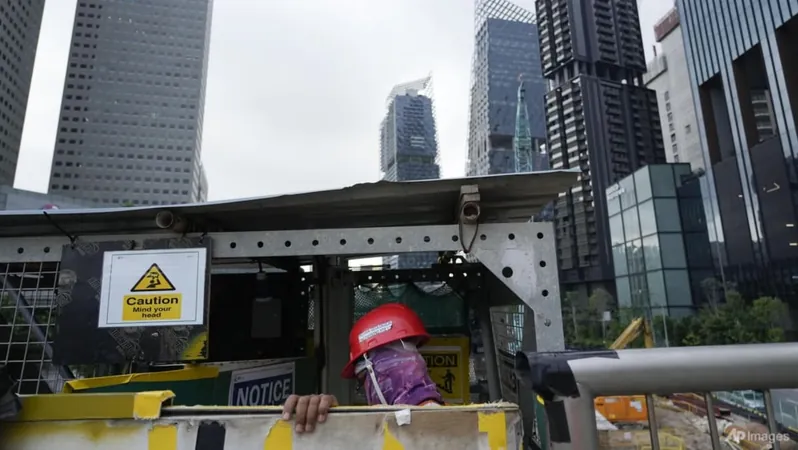
Shocking Rise: Workplace Deaths in Singapore Spike to 43 in 2024!
2025-03-26
Author: Yu
**SINGAPORE**: In a harrowing report released by the Ministry of Manpower (MOM) on March 26, 2024, it was revealed that workplace fatalities in Singapore surged from 36 in 2023 to a staggering 43 this year. This alarming increase of 19% raises serious concerns regarding safety protocols across various industries, particularly in construction, which accounted for nearly half of the deaths.
The statistics paint a troubling picture: the workplace death rate climbed to 1.2 deaths per 100,000 workers, up from 0.99 in the previous year. While there was some good news with a 2.8% decline in overall injuries—from 22,787 in 2023 to 22,157 in 2024—this does little to overshadow the tragic loss of life.
Deadly Trends Emerged in the Construction Sector
The construction industry proved to be the deadliest sector, recording 20 fatalities last year, with a steady increase in deaths since 2020, when only nine fatalities were reported. Additionally, the transportation and storage industry followed with nine deaths, while the marine industry saw five fatalities. Other sectors, such as water supply and waste management, reported three deaths, and manufacturing accounted for two.
The MOM identified the top three causes of fatalities in 2024 as vehicular incidents, drownings, and collapses of structures or equipment, which collectively resulted in 24 deaths or 56% of the total fatalities.
Furthermore, specific issues were highlighted that call for immediate action: in the latter half of 2024 alone, the construction sector witnessed 15 deaths, prompting MOM to label workplace safety standards in the industry as "concerning." A voluntary safety time-out was introduced in November to bolster safety measures following a spate of fatalities, urging construction firms to reinforce protocols.
Marine Industry's Alarming Statistics
The marine sector, despite having seen zero fatalities in 2023, experienced a surge in its death rate to an alarming 8.1 per 100,000 workers in 2024, as four of the five fatalities were connected to vessel operations. Diving operations also emerged as a significant concern due to observed lapses in safety protocols.
MOM and the Maritime and Port Authority of Singapore have vowed to enhance enforcement activities and take stringent measures against companies and individuals who do not adhere to safety regulations.
Positive News on Major Injuries, But Warnings Persist
Despite the spike in fatalities, Singapore celebrated its lowest rate of major workplace injuries in 2024, with just 15.9 major injuries per 100,000 workers—down from 16.1 in 2023. The total number of major injuries was 587, slightly less than the 590 recorded in the previous year. The construction sector again led in major injuries with 146 cases, while manufacturing followed closely with 123 injuries.
The MOM highlighted the primary causes of major injuries as slips, trips and falls, machinery incidents, and falls from heights, which together accounted for over 60% of the injuries.
Taking Action: MOM's Strategy Moving Forward
In a decisive response to these troubling trends, MOM has conducted over 17,000 inspections focused on high-risk industries such as construction, manufacturing, and marine, enforcing more than 16,000 safety breach corrections. They reiterated Singapore’s position as a top performer in workplace safety globally, boasting an impressive five-year average workplace fatality rate of just 1.1 per 100,000 workers.
However, the ministry emphasizes the urgency for all stakeholders—including employers, contractors, and workers—to maintain vigilance and prioritize workplace safety and health (WSH) standards. "Strengthening Singapore’s culture of WSH excellence is a collective effort and a non-negotiable priority," MOM stated. “We cannot afford to lose sight of safety, as our recent record lows highlight the potential for improvement."
What Does the Future Hold?
As Singapore strives to improve its safety record, the rising number of workplace deaths serves as a stark reminder of the importance of robust safety practices. It is crucial for all involved in these high-risk industries to take action now to prevent further tragedies—because every life lost is one too many. Will 2025 mark a turning point or will we continue to see this distressing trend? Stay tuned as we watch these developments unfold.






 Brasil (PT)
Brasil (PT)
 Canada (EN)
Canada (EN)
 Chile (ES)
Chile (ES)
 Česko (CS)
Česko (CS)
 대한민국 (KO)
대한민국 (KO)
 España (ES)
España (ES)
 France (FR)
France (FR)
 Hong Kong (EN)
Hong Kong (EN)
 Italia (IT)
Italia (IT)
 日本 (JA)
日本 (JA)
 Magyarország (HU)
Magyarország (HU)
 Norge (NO)
Norge (NO)
 Polska (PL)
Polska (PL)
 Schweiz (DE)
Schweiz (DE)
 Singapore (EN)
Singapore (EN)
 Sverige (SV)
Sverige (SV)
 Suomi (FI)
Suomi (FI)
 Türkiye (TR)
Türkiye (TR)
 الإمارات العربية المتحدة (AR)
الإمارات العربية المتحدة (AR)